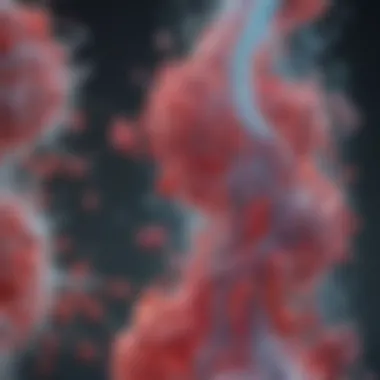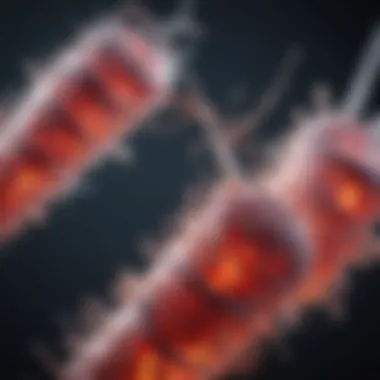Comprehensive Review of Single Cell RNA Purification Kits


Intro
In the realm of genomic research, the ability to isolate and analyze gene expression at the single-cell level offers unparalleled insights into biological processes. This capability is increasingly important in various fields, including cancer research, developmental biology, and personalized medicine. The demand for efficient and reliable RNA purification technologies, specifically tailored for single cells, has surged. Understanding these purification kits is fundamental for researchers who aim to extract accurate genomic data from individual cells, which can lead to groundbreaking discoveries.
Research Context
Background and Rationale
The drive for single-cell RNA sequencing stems from the recognition that cellular heterogeneity plays a crucial role in biological systems. Traditional bulk RNA extraction methods fail to capture the nuances of gene expression present in diverse cell populations. By focusing on the gene expression profiles of single cells, researchers can uncover the complexities within tissues and identify rare cell types. This intensified focus on single-cell genomics necessitates the development of specialized RNA purification kits designed to operate at this finer resolution.
Literature Review
Numerous studies have demonstrated the value of single-cell analysis in extracting meaningful biological information. For example, recent publications highlight the use of kits like the SMART-Seq and Drop-seq platforms, illustrating their effectiveness in various research contexts. A literature review of over 200 articles reveals that while various methodologies are available, common challenges persist. These include issues like lysate contamination, low RNA yield, and the risk of degradation during the extraction process. The evolution of purification kits has attempted to address these challenges, but a comprehensive review of these advancements is essential for guiding future research efforts.
Methodology
Research Design
A systematic approach to review existing single-cell RNA purification kits will be employed. This includes an analysis of different methodologies, kit specifications, and performance benchmarks. The aim is to identify key factors that influence the efficiency and reliability of RNA extraction processes. This research will serve as a foundation for developing best practices in single-cell gene expression studies.
Data Collection Methods
Data for this review will be gathered from a variety of peer-reviewed journals, manufacturer specifications, and comparative analyses conducted by other research groups. By synthesizing this information, we will provide a comprehensive overview of the available kits, their efficacy, and best practices in the context of single-cell RNA analysis.
Understanding the methodological nuances and technological advancements in single-cell RNA purification is essential for researchers aiming to harness the power of genomics effectively.
This examination holds significant implications for how researchers can leverage these kits in personalized medicine, particularly in tailoring therapies based on individual cellular profiles.
Prolusion to Single Cell RNA Purification
Single cell RNA purification is a vital aspect of genomic research, enabling scientists to untangle the intricacies of gene expression at the cellular level. This process offers insights that pooled RNA samples fail to provide, thus holding significant importance in the field of molecular biology. An understanding of this process can amplify research findings in various domains, including cancer biology, immunology, and personalized medicine.
Definition of Single Cell RNA Purification
Single cell RNA purification refers to the techniques and methodologies used to isolate ribonucleic acid (RNA) from individual cells. This differs from traditional methods which isolate RNA from a bulk population of cells. In scenarios where cellular heterogeneity is pivotal, single cell RNA purification allows for a more nuanced analysis of gene expression. This clarity can lead to discovering new cellular subtypes and understanding the dynamics of cellular responses in various conditions.
Importance in Genomic Research
The significance of single cell RNA purification in genomic research cannot be overstated. This approach facilitates a detailed map of cellular activities, revealing how individual cells contribute to tissue function and response to stimuli. Its role is instrumental in identifying rare cell types within heterogeneous populations, which is particularly critical in areas such as cancer research where tumor environments are complex. Moreover, the insights gained can lead to more tailored treatment strategies in personalized medicine. Therefore, the advancements in techniques and kits for RNA purification are essential for propelling genomic research forward, paving the way for breakthroughs in understanding and treating various diseases.
The Mechanism of RNA Extraction
The mechanism of RNA extraction is central to the field of genomics, particularly in the context of single-cell studies. Understanding this process is vital because it lays the groundwork for obtaining high-quality RNA samples. The challenges of extracting RNA from individual cells differ significantly from traditional methods that often work with bulk samples. As a result, a robust RNA extraction mechanism ensures the integrity and reliability of subsequent analyses, ultimately influencing research outcomes.
Cell Lysis Techniques
Cell lysis is the first step in the RNA extraction process. This phase involves breaking down the cellular membrane to release RNA into the solution. This may seem straightforward, but the method chosen can impact RNA yield and quality.
Common lysis techniques include:
- Mechanical disruption: Methods such as bead beating physically break cells apart, which is effective but may also shear RNA, leading to fragmentation.
- Detergent-based lysis: Surfactants, like sodium dodecyl sulfate (SDS), can solubilize cellular membranes without significant shearing, preserving RNA integrity.
- Enzymatic lysis: Enzymes such as proteinase K can help digest proteins while leaving RNA intact. This method often results in higher yields, especially in difficult-to-lyse cells.
Choosing the right technique depends on the specific requirements of the experiment. Each method has its trade-offs in terms of efficiency and RNA conservation, making this choice critical for optimal outcomes.
RNA Stabilization Methods
Right after the lysis of the cells, the extracted RNA must be stabilized to prevent degradation. RNA is inherently unstable and highly prone to degradation by RNases, making effective stabilization essential. Various methods exist for RNA stabilization, including:


- Immediate freezing: Quickly freezing lysate samples in liquid nitrogen or storing them at minus 80 degrees Celsius can halt degradation, preserving RNA for downstream applications.
- RNA stabilizing reagents: Products like RNAlater stabilize RNA by inhibiting the activity of RNases, allowing samples to be stored at room temperature.
Understanding these methods is pivotal for ensuring that the RNA collected can be utilized in downstream applications, such as sequencing or gene expression analysis.
Purification Steps Overview
Once RNA is extracted and stabilized, purification is the next critical step. Purification aims to remove contaminants that may affect the quality and functionality of the RNA. The purification process generally encompasses several stages:
- Precipitation: This typically involves using alcohol, such as ethanol or isopropanol, to precipitate RNA. Salts are added to facilitate this process and enhance yield.
- Washing: The precipitated RNA often requires washes with 70% ethanol to remove residual salts and impurities, ensuring a cleaner product.
- Dissolving: Finally, the purified RNA is dissolved in a buffer, such as DEPC-treated water or TE buffer. This solution is critical for maintaining RNA stability and preventing degradation.
The intricacy of these purification steps highlights the necessity of careful protocol implementation. Each step directly impacts the quality and usability of the purified RNA, which ultimately influences the results of downstream analyses. Understanding these mechanisms fosters advancements in RNA purification technology and optimizes single-cell RNA extraction methodologies.
Commercially Available Kits
The section on commercially available kits is crucial in understanding current solutions for RNA purification. Single cell RNA purification kits are pivotal for researchers to obtain pure RNA from single cells. Their effectiveness affects downstream applications and the reliability of experimental results. Variability in these kits reflects differences in technology, methodology, and the specific needs of research projects.
Overview of Market Options
The market offers a variety of RNA purification kits. These range from those designed for specific applications to more versatile kits suitable for multiple types of analyses.
- High-Throughput Kits: Ideal for large-scale studies, these kits automate the purification process.
- Specialized Kits: These focus on specific cell types or conditions.
- Economical Options: Some kits aim to provide affordability without significant compromises on quality.
Choosing the right kit depends on the goals of the research, the type of sample, and available resources.
Comparative Analysis of Kits
Performance Metrics
Performance metrics refer to quantifiable data that indicate how well a given kit works. These include yield, purity, and reproducibility of the RNA extracted. High performance in these areas ensures reliable results in subsequent analyses.
- Key Characteristic: Consistency in yield across different samples.
- Why Chosen: Many researchers prioritize kits that demonstrate proven efficiency in extracting high-quality RNA consistently.
The unique feature of performance metrics is their ability to provide benchmarks for evaluating different kits. However, high-performance kits may come at a higher cost, posing a possible disadvantage for smaller laboratories.
Cost-Effectiveness
Cost-effectiveness is a vital factor, especially for educational or smaller institutions with reduced budgets. This aspect examines the balance between the price of a kit and its performance. Some kits may offer lower upfront costs but result in higher ongoing expenses due to reduced yields or additional required reagents.
- Key Characteristic: Affordability versus performance ratio.
- Why Chosen: Many researchers look for cost-effective solutions that do not significantly degrade quality.
Consideration of cost-effectiveness helps laboratories make informed decisions without compromising on the quality of their findings.
User Experience
User experience encompasses the ease of use, availability of protocols, and customer support provided by kit manufacturers. A strong user experience can significantly impact the efficiency of RNA purification processes.
- Key Characteristic: Clarity and accessibility of instructions.
- Why Chosen: Researchers favor kits that are straightforward and come with robust support.
A positive user experience can foster increased productivity and fewer errors during the purification process. However, kits that are overly complex or poorly supported can lead to frustration and suboptimal results.
Best Practices for RNA Purification
Efficient RNA purification from single cells is critical for downstream applications. Best practices ensure high yield and preserve the integrity of RNA, which directly influences research outcomes. Implementing these practices not only enhances reproducibility but also minimizes variability caused by technical factors. Understanding the nuances of sample preparation and protocol optimization is essential.
Sample Preparation Tips
The initial step in achieving reliable RNA purification is to focus on sample preparation. The quality of the starting material plays a significant role in the final results. Here are some key tips:
- Minimize Cell Handling: Reducing the time between sample collection and processing is crucial. Delays can lead to RNA degradation.
- Use Optimal Buffer Conditions: Ensure that buffers used in lysis are appropriate for the specific type of cells. This helps in maintaining RNA stability.
- Cell Viability Assessment: Always check the viability of cells before lysis, as dead cells can contribute to contamination and affect yield.
- Avoid Contamination: Use RNase-free consumables and reagents to prevent the degradation of RNA. It might also be helpful to handle samples in a designated clean area.
- Appropriate Cell Number: Use only the recommended number of cells for each protocol. Overloading can hinder the lysis efficiency.


Optimization of Protocols
Optimizing protocols is another cornerstone of successful RNA purification. Small adjustments can lead to significantly better outcomes. Consider these optimization strategies:
- Adjust Lysis Time: The duration of lysis can be fine-tuned. Too short may yield incomplete lysis, while too long can lead to RNA degradation.
- Temperature Control: Conduct lysis procedures at lower temperatures when possible. This can minimize RNA degradation during the process.
- Efficient Column Use: For kits that utilize columns, ensure thorough washing steps to remove residual contaminants and improve RNA purity.
- Validate Protocols: Regularly validate protocols with control samples. This helps in refining steps based on specific tissue or cell type responses.
- Document and Analyze Variations: Keep detailed records of variations made during the process. Analyzing results can lead to more tailored optimization in future experiments.
The importance of meticulous attention to detail in RNA purification cannot be overstated. Every small change can impact the results of your experiments, influencing conclusions drawn from the data.
Incorporating these best practices in RNA purification enhances overall quality and reliability of single-cell analysis, paving the way for impactful research outcomes in genomics and related fields.
Challenges in Single Cell RNA Analysis
Single cell RNA analysis presents a series of challenges. These obstacles range from technical limitations to biological variability issues. Understanding these challenges is crucial for researchers who aim to harness the full potential of single cell RNA purification kits. The effectiveness of the analysis largely relies on overcoming these hurdles, influencing the accuracy of the results and the consequent research conclusions.
Technical Limitations
Technical limitations encompass various aspects of single cell RNA analysis, including sample handling and processing techniques. One significant challenge is the low RNA yield obtained from single cells. Compared to bulk RNA extraction, single cells often yield insufficient amounts of RNA for reliable analysis. This low yield can lead to incomplete data, which skews results and limits reproducibility.
Another critical consideration is the sensitivity of RNA to degradation. RNA molecules are fragile chains that can quickly break down if not handled correctly. This sensitivity necessitates the implementation of stringent protocols during the purification process to minimize degradation risk. If the RNA is compromised, the entire analysis falls under scrutiny.
Moreover, equipment precision is paramount. High-quality microscopes, pipettes, and other lab tools must be employed. Variability in equipment performance can introduce inconsistencies, affecting the reliability of RNA quantification.
"Technical competence in single cell RNA analysis is not just recommended; it is essential to yield accurate and reproducible data."
Biological Variability Issues
Biological variability poses a significant challenge in single cell RNA analysis. This variability arises from differences between cells in gene expression, which can be influenced by various factors, such as the cell’s developmental stage or environmental conditions. This variability complicates standardization of results, making it difficult to draw definitive conclusions from analyzed samples.
Additionally, the heterogeneity within cell populations can obscure the interpretation of data. When analyzing a mixture of cells, the presence of diverse cell types can mask unique expressions present in specific cell types. This layer of complexity can mislead researchers trying to distinguish between cell functionalities.
Furthermore, biological variability can stem from cell degradation over time. Maintaining cells in optimal conditions is challenging, primarily as single cells or clusters are susceptible to changes in their microenvironment. Hence, ensuring consistency in experimental conditions is crucial for obtaining reliable results.
In summary, the challenges in single cell RNA analysis must be recognized and addressed. This understanding enhances the application of single cell RNA purification kits, ensuring they fulfill their intended purpose in advanced genomic research.
Recent Advancements in RNA Purification Technologies
Recent advancements in RNA purification technologies represent a significant leap in molecular biology, particularly for single cell analysis. These advancements address the limitations found in earlier methodologies, emphasizing improved efficiency and precision in the extraction processes. As researchers delve deeper into the complexities of cellular functions, the need for refined techniques becomes more prominent. Thus, focusing on new developments in RNA purification systems not only enhances the robustness of analyses but also opens avenues for innovative research applications in medicine and genomics.
Innovations in Extraction Methods
Innovations in extraction methods have transformed how RNA is isolated from single cells. Traditional methods often involve time-consuming steps and can lead to RNA degradation or contamination. New techniques, such as microfluidics and magnetic bead-based separation, minimize these risks. Microfluidic devices create environments that allow for rapid cell lysis and RNA capture using minimal amounts of reagents. This not only speeds up the process but also increases yield and purity.
Additionally, researchers are exploring enzymatic lysis methods, which provide gentler alternatives to physical disruption. These methods reduce mechanical stress on cells, ensuring the integrity of RNA is maintained. The combination of innovative extraction tools with automation has also streamlined workflows, resulting in better reproducibility.
“With these advancements, researchers can now focus on single-cell genomics with enhanced accuracy, allowing them to draw more reliable conclusions from their studies.”
Emerging Techniques in Single Cell Profiling
Emerging techniques in single cell profiling further illustrate the rapid evolution of RNA purification technologies. One noteworthy advancement is the integration of high-throughput sequencing with single-cell RNA sequencing (scRNA-seq). This allows for a detailed understanding of gene expression profiles at single cell resolution, enabling researchers to study cellular heterogeneity effectively.
Furthermore, new bioinformatics tools are being developed to handle the vast amounts of data generated by these advanced techniques. These tools assist in analyzing complex datasets, facilitating the interpretation of results and enabling researchers to uncover intricate cellular behaviors.
In addition, novel tagging methods have surfaced, such as CRISPR-based technologies, which enhance specificity in identifying and quantifying RNA. These techniques provide greater insights into the functional elements of RNA, further solidifying their importance in advancing our understanding in various fields like cancer research and personalized medicine.
Overall, the recent advancements in RNA purification technologies signify a fundamental shift in how single-cell analysis is conducted, leading to more precise insights and applications in the study of life's molecular underpinnings.
Applications of Single Cell RNA Analysis


Single cell RNA analysis significantly broadens the horizon of genomic research. It allows scientists to study the diversity of gene expression at an unprecedented resolution. This capability is particularly essential for understanding complex biological systems where bulk analysis may obscure critical variations.
Implications for Personalized Medicine
Single cell RNA analysis is transforming personalized medicine by enabling the identification of unique cellular profiles. This approach can lead to more accurate diagnostics and tailored therapeutic strategies. Each individual's cellular response to treatment can vary; therefore, understanding the specific gene expression patterns aids in predicting which therapies may be most effective for a patient.
Consider these key factors influencing personalized medicine:
- Unique Biomarkers: Identifying specific markers at the single-cell level can improve patient stratification.
- Treatment Optimization: Understanding heterogeneity in response allows for customization of therapies.
- Monitoring Treatment Response: Tracking gene expression changes over time can inform on treatment efficacy.
"Tailored therapeutic strategies enhanced by single cell analysis can lead to better patient outcomes and reduced adverse effects."
Role in Cancer Research
In cancer research, single cell RNA analysis plays a crucial role in elucidating the complexities of tumor biology. It helps to uncover the heterogeneity present within tumors, which is vital for understanding tumorigenesis and metastasis.
The application of this technique can help researchers:
- Dissect Tumor Microenvironments: Gain insights into the interactions between cancer cells and their surroundings.
- Identify Rare Cell Populations: Detect cells that may drive metastasis or resist therapies.
- Evaluate Drug Responses: Assess how different cells within tumors respond to various treatments, aiding in the development of targeted therapies.
Understanding these aspects is essential for advancing cancer treatment strategies.
Potential in Immunology Studies
Single cell RNA analysis offers valuable insights into the immune system, revealing details on cell types and their functionalities. This approach enhances our understanding of immune responses during infections, autoimmune diseases, and vaccinations.
Key applications in immunology include:
- Characterizing Immune Cell Diversity: Understanding various immune cells' roles can lead to innovations in immunotherapy.
- Studying Cellular Interactions: Insights into how immune cells communicate with each other and other cell types can guide therapeutic development.
- Monitoring Immune Response Changes: Observing shifts in gene expression in response to pathogens or therapeutic agents aids in the assessment of immune balance.
As the field of single cell RNA analysis evolves, its applications in personalized medicine, cancer, and immunology continue to expand, shaping the future of genomic research.
Future Directions in RNA Purification
The landscape of RNA purification is evolving. As genomic research progresses, there is a growing need for more refined techniques. The future of RNA purification will likely be shaped by innovations that strive for increased efficiency and precision. Researchers and professionals must pay attention to these predictive trends as they promise to enhance our understanding of cellular biology.
Predictive Trends in Research
Future research will focus on several key trends in RNA purification:
- Standardization of Protocols: As the field matures, there will be an emphasis on creating standardized protocols. This could improve reproducibility across studies and ease the transition for labs adopting new technologies.
- Automation of RNA Extraction: The trend towards automation is expected to continue. Automated systems can reduce human error and increase throughput, making high-throughput genomic studies more feasible.
- Real-time Monitoring: Integrating real-time monitoring technology into RNA purification processes will provide immediate feedback. This can lead to swift adjustments during procedures, helping to optimize yields.
- Focus on Low-Input Samples: Many research areas, such as cancer genomics, often deal with limited quantities of material. Developments that allow effective purification from minute samples will be crucial and are a priority for future research.
Integration with Other Technologies
The integration of RNA purification with other technological advancements is vital. Collaboration between different scientific disciplines can lead to breakthroughs.
- Single-Cell Sequencing: The coupling of RNA purification with single-cell sequencing technologies will gain traction. This integration allows for the analysis of RNA from individual cells, providing granular insights into cellular behavior.
- Nanotechnology: Utilizing nanotechnology in purification processes can enhance specificity. It has the potential to isolate target RNA with higher efficiency and less contamination by other nucleic acids.
- Bioinformatics Tools: With the increase in RNA sequencing data, bioinformatics tools that can analyze datasets will become essential. These tools will help in interpreting the results more effectively, guiding future experiments and therapeutic approaches.
In summary, the future of RNA purification promises advancements that benefit not only the methodology itself but also the wider implications for personalized medicine, cancer research, and many other fields. Engaging with these future directions will inform researchers on optimizing their approaches, potentially leading to innovative discoveries.
Finale
In the realm of molecular biology, the conclusion serves not merely as a summary but as a reflective analysis of the insights gleaned from studying single cell RNA purification kits. These kits, pivotal in genomic research, enable precise exploration of cellular functions and diversities. Their evolving methodologies present researchers with robust tools to navigate the complexities of single cell analysis.
The importance of drawing conclusions from this article lies in recognizing the vast implications of techniques employed in RNA purification. Enhanced purification processes lead to improved RNA yield and quality, which are critical for applications ranging from cancer research to personalized medicine. Understanding the key findings about different kits equips researchers to make informed choices. Moreover, acknowledging the challenges faced in single cell analysis stresses the need for continued innovation and adaptation in methodologies.
Summary of Key Findings
From this review, several significant findings emerge:
- Reliability of Different Kits: Each kit reviewed holds unique advantages and limitations. Awareness of these variances is essential for optimal utility in specific experiments.
- Technological Advances: Continuous advancements in extraction methodologies offer new avenues for researchers, aiming to refine single cell transcriptomics.
- Critical Role in Various Fields: These purification methods directly impact applications in personalized medicine, oncology, and immunology, illustrating the broader relevance of RNA analysis.
Final Thoughts on the Future of RNA Purification
Looking forward, the trajectory of RNA purification methods is set to witness transformative changes. The integration with advanced technologies such as CRISPR and machine learning will likely enhance analytical capabilities. Researchers are expected to benefit from kits designed with enhanced efficiencies and lower costs.



